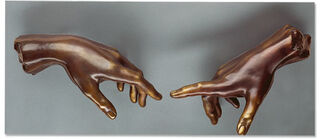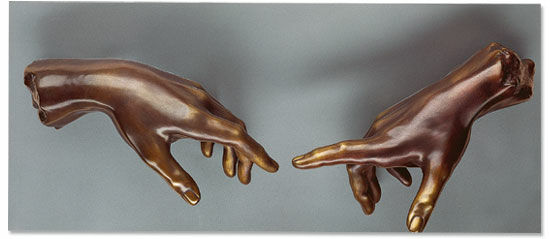Wall object "The Creation of Adam", bronze version
Wall object "The Creation of Adam", bronze version
Quick info
bronze | handmade | size 58 x 25 x 15 cm | weight 9 kg
Detailed description
Wall object "The Creation of Adam", bronze version
When Michelangelo created the vaulted frescoes of the Sistine Chapel in Rome between 1508 and 1512, he was already playing a decisive role in the Italian artistic and intellectual life. The ceiling fresco depicts the story of creation in nine scenes. In the centre, you can see two hands: the one on the left, when looking at the picture, belongs to Adam lying in bed, and the one on the right to God the Father descending from a cloud. The indirect touch of their two index fingers made the fresco famous: with incredible lightness and elegance, the gesture symbolises the miracle of creation. Michelangelo does not actually show the creation of the human being, but its animation shows the leaping over of the divine spark. The wall object lifts the core of the spectacular work into the third dimension. The object heightens the sculptural effect and concentrates entirely on the content: the longing for the divine and its satisfaction in gifted art.
Original: Sistine Chapel, Rome.
Edition in bronze. Cast by hand using the Lost-Wax-Process. Size 58 x 25 x 15 cm. Weight 9 kg.
Customer reviews
Ich bin total begeistert. Einfach wunderschön. Das Werk von Michelangelo wird meisterhaft in der 3. Dimension dargestellt. Schön das es euch gibt.
About Michelangelo Buonarroti
1475-1564
Michelangelo depicted pain and despair but also hope in his prehistory of mankind: the Sistine Chapel in the Vatican. When he created these vaulted frescoes between 1508 and 1512, the main representative of the High Renaissance and pioneer of Mannerism was already playing a central role in Italian artistic and intellectual life as a sculptor and painter.
Michelangelo Buonarroti was born in Caprese, Tuscany, in 1475. He trained as a painter under Domenico Ghirlandaio, and as a sculptor probably under Bertoldo di Giovannis, whereby the study of antiquity was a major influence.
From 1496 to 1501, Michelangelo worked in Rome, where among other projects he created the "Pietà" for St Peter's Basilica. Until 1504, he worked in Florence on the monumental statue of "David", which still shows the close connection to antiquity. The following sculptures mark the transition to Mannerism through intense moments of movement.
In 1505, Michelangelo received the commission for the tomb of Pope Julius II. However, it was only completed in a reduced way after his death in 1513 because the stubborn artist could not come to an agreement with the client. The "Bound Slaves" and "Moses" were created in 1516. He was to work as an architect for the Medicis but was unable to realise the planned building and instead implemented the design he had developed in the staircase of the Biblioteca Laurenziana in Florence, starting in 1521.
As of 1534, Michelangelo lived in Rome for good.
Michelangelo's late work is characterised by an intensive preoccupation with religious themes but also with architectural plans, such as the supervision of the construction of St. Peter's Church or the Palazzo Farnese. Through his letters and sonnets, we can also discover Michelangelo the poet, who died in 1564.
An alloy of copper with other metals (especially with tin) used since ancient times.
When casting bronze, the artist usually applies the lost-wax technique which is dating back more than 5000 years. It's the best, but also the most complex method of producing sculptures.
First, the artist forms a model of his sculpture. It is embedded in a liquid silicone rubber mass. Once the material has solidified, the model is cut out. The liquid wax is poured into the negative mould. After cooling down, the wax cast is removed from the mould, provided with sprues and dipped into ceramic mass. The ceramic mass is hardened in a kiln, whereby the wax flows out (lost mould).
Now we finally have the negative form, into which the 1400° C hot molten bronze is poured. After the bronze had cooled down, the ceramic shell is broken off and the sculpture is revealed.
Now the sprues are removed, the surfaces are polished, patinated and numbered by the artist himself or, to his specifications, by a specialist. Thus, each casting becomes an original work.
For lower-quality bronze castings, the sand casting method is often used which, however, does not achieve the results of a more complex lost-wax technique in terms of surface characteristics and quality.
A plastic work of sculptural art made of wood, stone, ivory, bronze or other metals.
While sculptures from wood, ivory or stone are made directly from the block of material, in bronze casting a working model is prepared at first. Usually, it is made of clay or other easily mouldable materials.
The prime time of sculpture after the Greek and Roman antiquity was the Renaissance. Impressionism gave a new impulse to the sculptural arts. Contemporary artists such as Jorg Immendorf, Andora, and Markus Lupertz also enriched sculptures with outstanding works.


